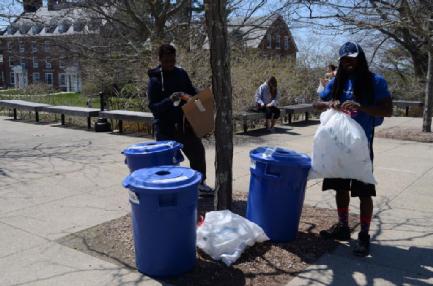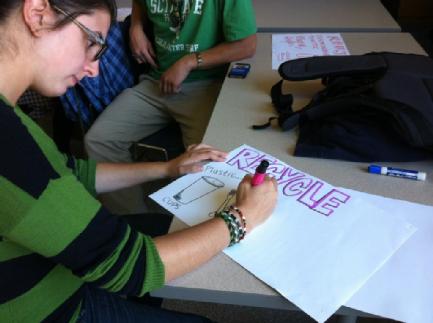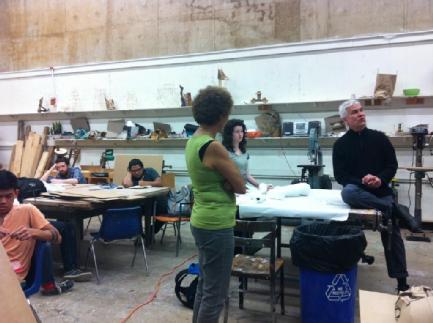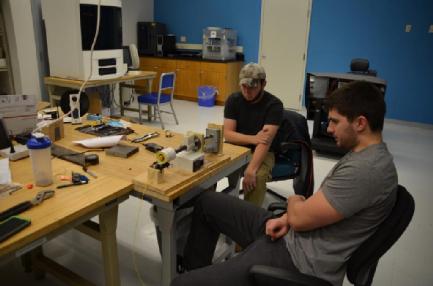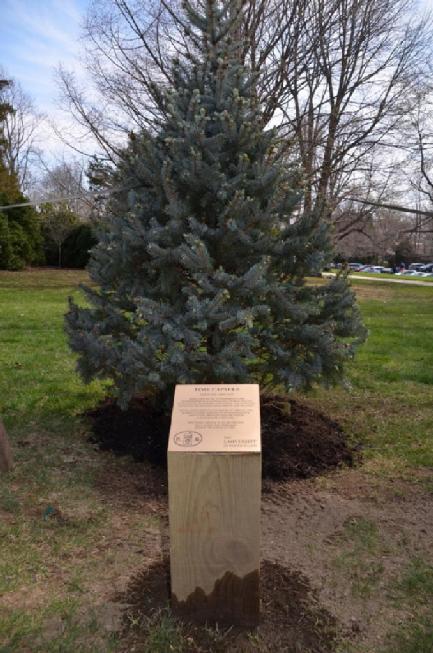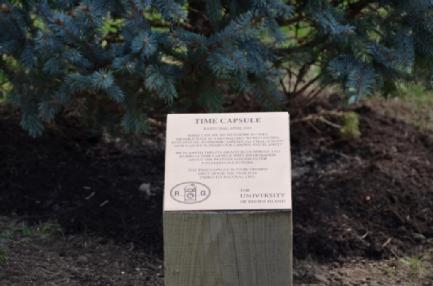ReUse
ReUse is a disposable food packaging project at the University of Rhode Island. It raises awareness of disposable food and beverage packaging, encourages its avoidance and promotes the reuse of natural resources. The project enriches the discourse about a sustainable campus and helps the university pioneer innovative ways to promote conservation and recycling. The interdisciplinary and participatory project with the College of Engineering and the Departments of Art and Art History, Film & Media and Communication Studies is an open process where different knowledge is explored to understand the complexity of circles and to translate it into a sustainable design. Students learn problem-based approaches inside and outside the classroom. They develop an understanding of interconnections within this interdisciplinary practice.
A group of students from Engineering and Art worked together with the recycled plastic collected on campus. The aim was to find out if it is posssible to use this plastic for 3d printing. Several meetings in the Engineering and Sculpture Lab took place. They showed the complexity of working with Polypropylene. Engineering students Jon, Hunter and Rachel constructed a Filastruder and winder to extrude filaments from the collected plastic. The first test worked well. The extruder made approximately 80 grams of rough test filament. Even though it was not pure enough for printing, it was great to see how we can produce our own filaments. Jon and Hunter even experimented succesfully with different colors. In the next step the plastic was granulated. There was extruded a filament with 95 % Polypropylene and added 5% of the recycled plastic. The filament appeared to be irregular, stiff and easily breakable. Unfortunately it is not useable for 3d printing. There are too many additives. Prof. Manbir Sodhi from the Engineering Department planned to continue experimenting with the recycled plastic.
Another aim of the activities ist to provide information on sustainable life and to preserve ideas and items for upcoming generations. Therefore a time capsule was created. It was handed over to future discoverers during a tree planting on Earth Day 2015. A tree with its annual rings is also a natural time capsule. It provides information for instance on dryness or nutrition. The actual time capsule contains answers to questions given by faculty members and students: “In which social order will we live in the future?" or "What awareness can we contribute to a globalized world with increasing ecological, economic and social changes?”. There are reports from various faculties, ideas and visions by students. Also there are seeds of an endangered wildflower species from Rhode Island. The time capsule contains as well small objects like an unrecyclable styrofoam cup as a symbol of the end of the carbon age. The future in a human life is predictable and imaginable only for a short term. The live span of the tree is about 100 years. When its natural life ends, the time capsule can be opened.
Read more about the project at https://reuseplastic.wordpress.com/
back...
ReUse is a disposable food packaging project at the University of Rhode Island. It raises awareness of disposable food and beverage packaging, encourages its avoidance and promotes the reuse of natural resources. The project enriches the discourse about a sustainable campus and helps the university pioneer innovative ways to promote conservation and recycling. The interdisciplinary and participatory project with the College of Engineering and the Departments of Art and Art History, Film & Media and Communication Studies is an open process where different knowledge is explored to understand the complexity of circles and to translate it into a sustainable design. Students learn problem-based approaches inside and outside the classroom. They develop an understanding of interconnections within this interdisciplinary practice.
A group of students from Engineering and Art worked together with the recycled plastic collected on campus. The aim was to find out if it is posssible to use this plastic for 3d printing. Several meetings in the Engineering and Sculpture Lab took place. They showed the complexity of working with Polypropylene. Engineering students Jon, Hunter and Rachel constructed a Filastruder and winder to extrude filaments from the collected plastic. The first test worked well. The extruder made approximately 80 grams of rough test filament. Even though it was not pure enough for printing, it was great to see how we can produce our own filaments. Jon and Hunter even experimented succesfully with different colors. In the next step the plastic was granulated. There was extruded a filament with 95 % Polypropylene and added 5% of the recycled plastic. The filament appeared to be irregular, stiff and easily breakable. Unfortunately it is not useable for 3d printing. There are too many additives. Prof. Manbir Sodhi from the Engineering Department planned to continue experimenting with the recycled plastic.
Another aim of the activities ist to provide information on sustainable life and to preserve ideas and items for upcoming generations. Therefore a time capsule was created. It was handed over to future discoverers during a tree planting on Earth Day 2015. A tree with its annual rings is also a natural time capsule. It provides information for instance on dryness or nutrition. The actual time capsule contains answers to questions given by faculty members and students: “In which social order will we live in the future?" or "What awareness can we contribute to a globalized world with increasing ecological, economic and social changes?”. There are reports from various faculties, ideas and visions by students. Also there are seeds of an endangered wildflower species from Rhode Island. The time capsule contains as well small objects like an unrecyclable styrofoam cup as a symbol of the end of the carbon age. The future in a human life is predictable and imaginable only for a short term. The live span of the tree is about 100 years. When its natural life ends, the time capsule can be opened.
Read more about the project at https://reuseplastic.wordpress.com/
back...
